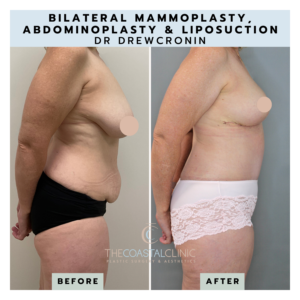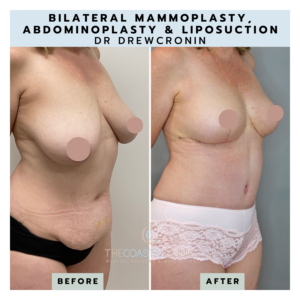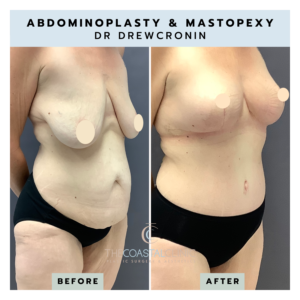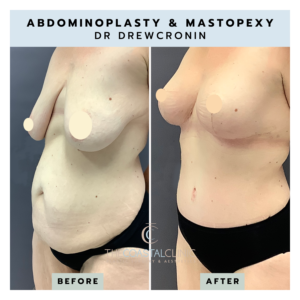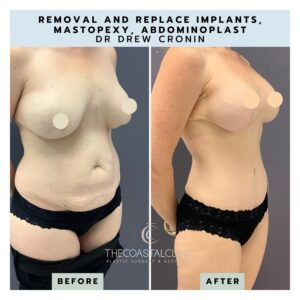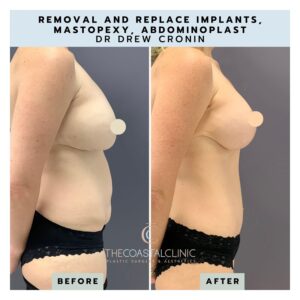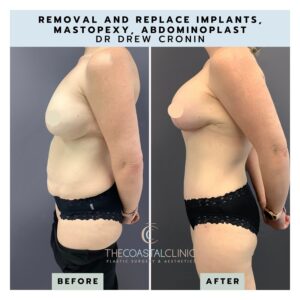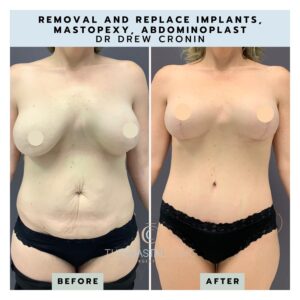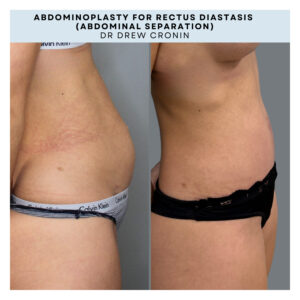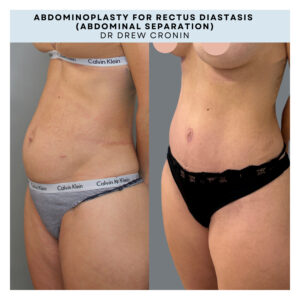
Abdominoplasty (Tummy Tuck)
Abdominoplasty, or commonly referred to as a tummy tuck, is a surgical procedure designed to remove excess skin and fat from the abdominal area and tighten the underlying muscles to create a smoother, firmer abdominal profile. It is often sought by individuals who have experienced significant weight loss, pregnancy, or aging, which can lead to loose, sagging skin and weakened abdominal muscles. The procedure can help improve the appearance and contour of the abdomen, enhancing both aesthetic and functional outcomes.
Who is a good candidate for a tummy tuck (abdominoplasty)?



Good candidates for abdominoplasty surgery are individuals who have:
Excess Skin and Fat
Tightened Abdominal Muscles
Changes to Weight
Weakened Muscles
Good Overall Health
Stable Weight
While abdominoplasty can be a cosmetic procedure, it is also reconstructive in that it is necessary to:
- Correct abdominal abnormalities caused by extensive weight loss
- Improve the function of abdominal muscles and pelvic floor
- Remove a large and distressing apron of fat or “pannus”
benefits of a tummy tuck (abdominoplasty)?
The benefits of a tummy tuck, or abdominoplasty, include:
- Improved abdominal contour through removal of excess skin and fat, resulting in a flatter, firmer, and more toned abdomen.
- Tightened abdominal muscles through the repair and tightening of separated or weakened abdominal muscles may result in enhancing core stability and strength.
- Enhanced posture by strengthened abdominal muscles can lead to better posture and may reduce lower back pain.
- Reduction of stretch marks, particularly those located below the navel, as this area of skin is often removed during the procedure.
- Long-Lasting Results – with a stable weight and healthy lifestyle, the results of a tummy tuck can be maintained for many years.
How is a tummy tuck (abdominoplasty) performed?
Abdominoplasty surgery with our surgeons is performed as an inpatient procedure within one of the Gold Coast Hospitals we operate from.
Anaesthesia
The patient is administered general anaesthesia.
Incision
The surgeon makes a horizontal incision just above the pubic area, extending between the hip bones. The length and shape of the incision depend on the amount of excess skin to be removed.
Muscle Repair
The surgeon tightens and sutures the weakened or separated abdominal muscles, creating a firmer abdominal wall and narrower waistline.
Excess Skin Removal
The surgeon removes excess skin and fat. The remaining skin is then pulled down and sutured together.
Navel Repositioning & Closing
If necessary, a new opening is created for the navel, which is brought out through the skin and sutured into position.
The incisions are closed with three layers of absorbable sutures. Drains are placed under the skin to remove excess fluid and reduce swelling.
When is abdominoplasty medically necessary?
In some cases, Medicare rebates may be accessed for Tummy Tuck/Abdominoplasty surgery. It may be that the redundant skin and fat interferes with the activities of daily living or perhaps you’re experiencing rectus diastasis post-pregnancy.
– Read more about muscle repair/rectus diastasis
– Read more about medicare rebates for significant weight loss
If you have private health insurance, it is important to contact your provider directly to discuss your eligibility and/or the waiting periods which may apply.

Recovery & Aftercare
You will usually be discharged home from hospital the same day. You are required to have someone pick you up from the hospital and remain with you for the first 24hours. You will be placed in a support garment which is to be worn at all times for the first 6weeks. Surgical garments provide compression to the site and assist in reducing swelling and support healing.
You will usually be discharged home from hospital the same day. You are required to have someone pick you up from the hospital and remain with you for the first 24hours. You will be placed in a support garment which is to be worn at all times for the first 6weeks. Surgical garments provide compression to the site and assist in reducing swelling and support healing.
Post-operative pain is managed with prescribed medications to ensure comfort during recovery.
You will have an initial review with our nurse during the first post-operative week, and at each week until your incisions are healed and your pain has resolved. Drains are typically removed by the end of the first week. Occasionally the drains may be required to stay in for longer. 6 weeks post-operatively you will have a review with Dr Cronin. Regular follow -ups with Dr Cronin at 3months, 6 months and 12months are also essential to monitor your surgical outcome.
Patients are advised to limit physical activities and avoid strenuous exercises for several weeks post-surgery. Light walking is encouraged to promote circulation, but heavy lifting and intense activities should be avoided until cleared by the surgeon. Generally you can return to driving a car around 2weeks.
Proper scar care is essential for optimal healing. Patients are advised on proper scar care techniques to minimise scarring. Keeping the incision site clean and protected from sun exposure is crucial.
We offer an add on package for a scar treatment plan to all of our surgical patients.
Final results of an abdominoplasty can be seen after several months, once swelling has completely subsided and tissues have settled. Patients can expect a flatter, firmer abdominal contour, with continued improvement over the first year post-surgery.



Abdominoplasty Before and After Gallery
Individual results will vary from patient to patient and according to factors including genetics, age, diet, exercise. All invasive surgery carries risk and requires a recovery period and care regime. Be sure you do your research and seek a second opinion from an appropriately qualified Specialist Plastic Surgeon before proceeding. Any details are general in nature and are not intended to be medical advice or constitute a doctor-patient relationship.
For comprehensive information on the potential risks and post-surgery recovery process, please see risks associated with surgery section towards the bottom of this page.
Frequently Asked Questions
If we haven’t addressed your inquiries yet, here are some frequently asked questions that may provide the information you’re looking for. However, if you still have any remaining questions or concerns, please don’t hesitate to reach out to our clinic at 07 5683 0820 or via email at admin@thecoastalclinic.com.au. Our team is ready to assist you.
The decision to undergo breast augmentation after a history of breast cancer should be made on an individual basis in consultation with your oncologist and a certified plastic surgeon such as Dr Drew Cronin with experience with breast reconstruction. There are several factors to consider, including the type and stage of breast cancer.
Yes, it is possible to combine abdominoplasty (also known as a tummy tuck) with liposuction. In fact, it is a common practice for plastic surgeons to perform both procedures together.
Abdominoplasty focuses on removing excess skin and tightening the abdominal muscles, it can also involve the removal of some stretch marks in the lower abdominal area should that skin be removed during your procedure.
However, it’s important to note that stretch marks located above the belly button or on the upper abdomen typically cannot be directly addressed during an abdominoplasty because the focus is primarily on the lower abdomen.
The results of a Tummy Tuck are visible immediately after surgery.
The results of a tummy tuck (abdominoplasty) can be long-lasting if the patient adheres to a healthy lifestyle, including regular exercise and a balanced diet. Significant weight fluctuations or pregnancies post-surgery can affect the results.
Depending on the type of work you perform, our surgeons generally recommend taking 2-6 weeks off work. Patients are typically able to drive 2-3 weeks after their procedure. Your surgeon will discuss this with you in detail during your consultation.
As part of your surgical plan, your Surgeon will provide you with post-operative care instructions. It’s important to rest and follow your care plan to avoid complications or extend the time needed to recover.
There are three types of breast implant surfaces available.:
Smooth breast implants have a smooth, non-textured surface. They move feely within the breast pocket and feel very soft. However they have been found to have a higher risk of capsular contracture and rupture.
Nano-textured implants have a very fine, uniform texture created using advanced manufacturing techniques. They are most commonly used by Dr Cronin as the fine texture promotes better tissue integration, helping to stabilise the implant and reduce the likelihood of movement or rotation. There is also a reduced risk of capsular contracture compared to smooth implants.
Textured– Micro textured breast implants have a more pronounced and rougher surface which improves the stability of the implant. Micro-textured implants have also been shown to reduce capsular contracture compared to smooth breast implants. Macro textured implants are no longer available in Australia.
During your consultation with Dr Cronin, he will suggest the most appropriate implant type for you.
An abdominoplasty performed as a stand alone surgery typically takes 2.5 hours.
Diet
A healthy diet can assist in the recovery process. Eat a well-balanced diet rich in fruits, vegetables, lean protein, and whole grains to support your body’s healing capabilities and always stay hydrated.
Smoking
If you smoke, it is strongly recommended to quit smoking several weeks before the surgery. Smoking can negatively impact the healing process and increase the risk of complications.
Support in the home
During the initial phase of recovery, you may require assistance with daily activities, particularly if you have small children or dependents. Arrange for a responsible adult to help you with household chores, childcare, or transportation during the early days after surgery.
Stay active
Regular exercise can help improve your overall fitness and assist in the recovery process.
Yes you will require a doctor’s referral to book a consultation with our surgeons.
If your surgery is medical in nature, a Medicare rebate for part of your consultation fee is applicable with a referral from your family doctor.
Yes, men can have a tummy tuck (abdominoplasty). The procedure is not gender-specific and can benefit anyone with excess abdominal skin and fat or weakened abdominal muscles. Men who have experienced significant weight loss, have excess skin due to aging, or wish to improve their abdominal contour can consider this surgery.
The benefits for men are similar to those for women, including a flatter and firmer abdomen and improved posture. As with all candidates, it is important for men to be in good overall health, have realistic expectations, and discuss their goals with a qualified plastic surgeon.
Risks of Surgery
As part of our commitment to delivering exceptional patient care, we aim to provide you with comprehensive information regarding the general risks associated with surgical procedures, anaesthesia, and procedure-specific risks.
- Acute medical event: Heart or lung complications (e.g. heart attack, stroke, chest infection)
- Death
- Deep Vein Thrombosis (DVT) or Pulmonary Embolisms (PE)
- A sore throat/breathing difficulty due to the general aesthetic or the endotracheal tube, which can cause swelling, noisy breathing or discomfort
- Short-term nausea following general anaesthesia
- Wound infection, which may result in treatment with antibiotics or further treatment/surgery. This is more likely in a smoker or a person with diabetes.
- Heavy bleeding from the wound, which may result in further treatment/surgery
- Wound discharge
- Poor or slow healing of the skin; wound breakdown; skin necrosis
- Wound dehiscence (wound ruptures along the surgical incision)
- Bruising and swelling. This will start to subside in one to two weeks but can take up to several months to settle
- Abscess/Haematoma/Seroma/Oedema
- Pain and discomfort
- Allergic reaction to sutures, dressing, antiseptic solutions
- Altered or loss of sensation in and around the treated area, which may persist for some months, numbness maybe permanent
- Adverse scarring
- Revisionary surgery
- Psychological impact of change in appearance
- Unsatisfactory cosmetic appearance
- Seroma
- Haematoma
- Prologned drain duration or reinsertion
- Puckering at wound edges
- Parasthesia (may be nubness or tingling)
- Change in the appearence of the umbilicus
- Prominent Scars
- Loss of nipple sensation
- Parasthesia (may be numbness or tingling)
- Asymmetry
- Capsular contracture
- Infection
- Reoperation
- Rupture of implants
- BIA- ALCL
- Rotation of implants
- Migration of implants





